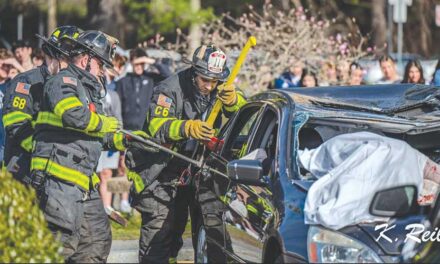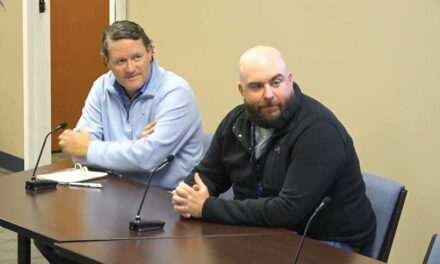Published in the December 6, 2017 edition
By DAN TOMASELLO
LYNNFIELD — Vaping and suicidal thoughts were among several red flags raised in the results of the 2017 Youth Risk Behavior Survey (YRBS).
The survey’s findings were revealed during a joint Board of Selectmen and School Committee meeting on Nov. 28. The selectmen and school board have formed a partnership in order to address substance abuse as well as to develop prevention methods the town and schools can implement.
Teaching and Learning Director Kevin Cyr said the survey was administered to middle school students in seventh and eighth grade, and high school students in grades 9-12. The survey was last administered in the fall of 2014.
The survey focused on six different areas: Unintentional injury and violence, mental health, alcohol and drugs, tobacco, sexual behaviors, and nutrition and physical activity. The survey was administered electronically, and questions were voluntary.
Cyr thanked Christine Healey and Denis Gallagher from Lahey Health, who awarded the town’s substance abuse coalition, A Healthy Lynnfield, a $17,000 grant. The grant allowed the School Department to administer the survey.
“We want to have a pulse of what is going on in our schools, and that is what this is all about,” said Cyr.
LMS results
Lynnfield Middle School Assistant Principal Tom Sallee, middle school psychologist Cara Mancuso and wellness teacher Sheri Weeks gave an overview of the survey’s middle school results.
Sallee said 43.6 percent of middle school students reported never or rarely wearing a helmet when riding a bicycle. He said 71.6 percent of students said they never or rarely wear a helmet when rollerblading or riding a skateboard.
According to Sallee, 1.8 percent of middle school students reported never wearing a seatbelt in a car. He said 15.3 percent of students said they have rode in a car driven by someone who had been drinking alcohol.
Sallee said 28.6 percent of students said they have been in a physical fight, totaling 77 students. While Sallee has found very few students carrying a weapon at LMS, he said 19 percent of students reported carrying one.
According to Sallee, 15.1 percent of students reported being bullied online and 29.1 percent said they were bullied on school property.
Mancuso said 7.9 percent of middle school students said they have contemplated suicide. She said 17 students made a plan to commit suicide and seven students attempted suicide.
“Those numbers are low, but I don’t think they are low enough,” said Mancuso. “We want to get that down even further because it’s an alarming statistic.”
Weeks noted suicide prevention is incorporated into the middle school’s eighth grade health and wellness program.
“As alarming this statistic is, it did not surprise me,” said Weeks. “Years ago when I administered the survey when I was the health coordinator, the numbers were high. With the administration’s guidance, I made modifications to the curriculum to address these types of issues because students were talking about it.”
School Committee member Jamie Hayman said, “I don’t think these numbers are that small.”
“There is more than one child in every single homeroom when you start thinking about that,” said Hayman. “That is a scary number.”
In regard to stress, Mancuso explained that 34 percent of students said school demands caused the most stress in their lives.
Mancuso said 1.4 percent of middle school students reported trying a cigarette, and 0.7 percent are currently smoking cigarettes. She said 3.2 percent of students reported using vapor products and 1.8 percent of students are currently vaping.
According to Mancuso, 9.7 percent of middle school students reported ever drinking alcohol. She said 0.7 percent of students said they are currently drinking alcohol.
Mancuso said 1.5 percent of middle school students reported using marijuana. She said 2.6 percent of students said they have sniffed glue; breathed the contents of spray cans; or inhaled paints or sprays to get high. She said 1.5 percent of students reported using prescription drugs without a prescription.
Sallee said 1.9 percent of middle school students reported having sexual intercourse, totaling five students. He said all five students said they used a condom while having sex.
According to Sallee, 32.1 percent of middle school students said they play video games for three or more hours each day. He said the majority of middle school students play sports or are physically active.
LHS results
High School Assistant Principal Brian Bates, adjustment counselor Ella Bitman and nurse Mary Homan unveiled Lynnfield High School’s survey results.
Bates said 14.5 percent of high school students reported they have ridden in a vehicle with a driver who had been drinking alcohol in the last month. He said 2.3 percent of high school students said they have driven after consuming alcohol.
“This is something we talk a lot about at the high school whether it’s School Resource Officer Patrick Curran talking with students or bringing in guest speakers,” said Bates.
According to Bates, 41.7 percent of students reported they talked on a cell phone while driving. Additionally, he said 31.3 percent of students texted or emailed while driving. Bates said 4.3 percent of students reported they have carried a weapon a month before the survey was administered. He said 11.5 percent of students said they have been in a physical fight, equaling 72 students across four grades.
Bates said 8.3 percent reported being electronically bullied and 7.4 percent said they were bullied on school property. He said the high school has brought in guest speakers to discuss bullying this year as well as previous years.
According to Bates, 1.6 percent of high school students reported they have experienced physical dating violence. Bates said 4.2 percent of students reported they experienced sexual dating violence.
“It’s a small percentage, but it’s pretty concerning,” said Bates.
Bitman noted two students told her they were the victims of dating violence last year, and the authorities were contacted. She said there has been no cases reported this year.
“I do worry the number is being under reported, but the percentage remains small,” said Bitman.
Similar to the middle school’s survey results, Bitman said 7.6 percent of high school students considered attempting suicide. She said 6 percent made a plan and 2.1 percent attempted suicide.
“We have had two students hospitalized this year for suicidal thoughts or attempts,” said Bitman. “These numbers are really alarming.”
Homan said 11.3 percent of students reported taking medication or receiving treatment for behavioral health, mental health and emotional conditions. She said 33 percent of high school students said their busy schedules and 32 percent said schoolwork caused the most stress in their lives.
Bates said 7.5 percent of high school students reported trying cigarettes and 2.8 percent are currently smoking cigarettes.
While the percentage of high school students smoking cigarettes is low, Bates said 29.6 percent of students said they have used a vapor product and 22.3 percent of students are currently vaping. He held up a vapor product resembling a flash drive and said students are using the devices to smoke flavored water, vaping oils and cannabis oils.
“This is the biggest problem we have at the high school right now,” said Bates. “The numbers are pretty high.”
Bates said 45.1 percent of high school students reported ever drinking alcohol and 16.6 percent said they are currently drinking alcohol.
“It’s a pretty significant number and it’s something we battle at the high school,” said Bates.
Bates said marijuana use has dropped since the survey was last administered in 2014. He said 22.1 percent of high school students reported using marijuana and 11.6 percent said they are currently smoking marijuana.
Additionally, Bates said 2.8 percent of students said they used prescription drugs in order to get high. He said 3.3 percent of students reported using prescription drugs not prescribed to them in the last month. He said 7.3 percent of students received an illegal drug on school property in the last year.
Bitman said 19.3 percent of students said they have had sex, but believes “the number is being under reported.”
“I have met with many students who have said they are experimenting or engaging in sexual intercourse,” said Bitman.
Bitman said 17.9 percent of students said they were more willing to participate in sexual behavior if they had been drinking or using drugs. She said 26.8 percent of students reported not using a condom the last time they had sex. She said 5.4 percent said they were not using any methods of birth control.
Homan said 6 percent of students do not eat breakfast during the week and 79.4 percent reported they do not eat breakfast at least once a week. She said 38.1 percent reported playing video games for three or more hours on an average school day. She also said 14.8 percent of students are overweight.
Recommendations
Bates and Sallee unveiled a series of recommendations the secondary schools should implement moving forward.
Sallee said the middle school needs to increase social-emotional programing for students as well as providing more support for students dealing with stress. While the percentage of middle school students abusing alcohol and drugs is low, Sallee said the middle school should broaden substance abuse prevention programs. He also said the middle school would like to implement “small group session work” focusing on bullying and social conflicts.
Bates said the high school would like to expand its sex education program after students expressed a desire to receive more sex education at LHS. He also said the high school wants to implement a suicide prevention program and expand parent programming. He also said the high school wants to renovate the weight room in order to provide stress relief options for students during the school day. He said the high school wants to implement a mindfulness course as well.




